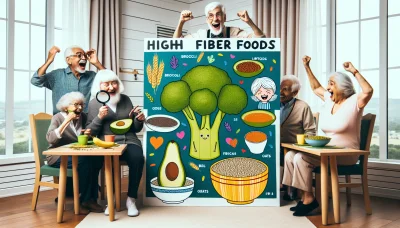High fiber low carb foods for diabetics Quiz
Test Your Knowledge
Question of
Understanding High Fiber, Low Carb Diets for Diabetics
The Role of Fiber in Diabetic Health
Fiber plays a crucial part in managing diabetes. It slows the absorption of sugar, helping to prevent spikes in blood glucose levels. A diet rich in high fiber foods is essential for diabetics to maintain stable blood sugar.
High fiber foods not only help in controlling blood sugar levels but also increase the feeling of fullness after meals. This can lead to reduced calorie intake and aid in weight management, a vital aspect for diabetics.
A significant benefit of fiber is its ability to lower the risk of heart disease. Diabetics are more susceptible to heart problems, making fiber's role in improving cholesterol levels and reducing blood pressure invaluable.
Stabilizing Blood Sugar Levels
Integrating high fiber foods into a diabetic's diet is a strategic approach to stabilize blood sugar. Soluble fiber, in particular, forms a gel-like substance that moderates how sugars are absorbed into the bloodstream.
Foods like legumes, fruits, and vegetables are excellent sources of soluble fiber and should be included in a diabetic's meal plan. Consistent intake of these foods can result in more predictable blood sugar patterns, which is a key goal in diabetes management.
Enhancing Satiety and Weight Control
Foods high in fiber have fewer calories relative to their volume, contributing significantly to satiety. Feeling fuller longer prevents overeating and snacking on unhealthy options that could spike blood sugar levels.
Maintaining a healthy weight is easier with a high-fiber diet as it naturally curbs excess calorie consumption. This is particularly beneficial for diabetics since weight control is often an important part of their health regimen.
Reducing Heart Disease Risk
Fiber's ability to improve cardiovascular health by lowering bad cholesterol (LDL) levels makes it an ally against heart disease. The risk of developing heart complications is higher for those with diabetes, so dietary fiber becomes even more significant.
- Eat plenty of fruits and vegetables daily for optimal heart health.
- Choose whole grains over refined ones to maximize the benefits of fiber.
- Incorporate nuts and seeds into your diet as they're good sources of healthy fats and fibers.
- Limit intake of saturated fats which can counteract the positive effects of fiber on heart health.
- Maintain regular check-ups with your healthcare provider to monitor your heart health alongside your diet.
Low Carb Diet Benefits for Diabetics
A low carb diet focuses on reducing carbohydrate intake to control blood sugar levels. For diabetics, this can mean better glycemic control and less dependency on medication. It's a powerful strategy that can make diabetes management more effective.
Managing Glycemic Control
By limiting carbohydrates, post-meal glucose spikes can be minimized. A low carb diet encourages the consumption of proteins and fats which have minimal impact on blood sugar levels compared to carbs. This promotes steadier glycemic readings throughout the day.
Promoting Fat Loss and Lean Muscle Maintenance
A reduction in carbs typically leads to using fat as an energy source, facilitating weight loss while preserving lean muscle mass. This shift not only improves body composition but also enhances insulin sensitivity, crucial for diabetics.
Decreasing Insulin Resistance
Insulin resistance is a common issue among individuals with diabetes. A low carb diet has been shown to decrease insulin resistance over time, potentially reducing the amount of insulin or medication needed by diabetics to manage their condition.
Essential Foods for a Diabetic-Friendly Diet
Top High Fiber Foods to Include
Integrating high fiber foods into your diet is a game-changer for managing diabetes. Dietary fiber slows carbohydrate digestion and sugar absorption, helping stabilize blood glucose levels. It's not just about quantity, but also the quality of the fiber.
Fiber-rich foods can be delicious and diverse. They add texture and flavor to any meal, turning mundane dishes into culinary delights that also support your health. Let's delve into some of the most beneficial high-fiber options you can enjoy today!
Leafy Greens and Cruciferous Vegetables
Leafy greens are nutritional powerhouses with minimal impact on blood sugar levels. Spinach, kale, and Swiss chard offer an abundance of nutrients with very few calories. Cruciferous vegetables like broccoli and cauliflower are also stellar choices, packed with vitamins, minerals, and fibers.
Eating a variety of green leafy vegetables ensures a broad intake of nutrients. These foods are versatile enjoy them raw in salads, steamed as side dishes, or blended into smoothies for a nutrient-packed drink!
Nuts, Seeds, and Legumes
Nuts and seeds are excellent sources of fiber, healthy fats, and protein that help manage hunger and blood sugar levels. Almonds, chia seeds, and flaxseeds are just a few options that can be easily incorporated into snacks or meals. Legumes such as lentils, chickpeas, and black beans are also rich in fiber and protein.
Incorporate these nutrient-dense foods into your diet by adding them to salads, yogurts, or enjoying them as hearty soups. They're not only good for you but also bring a satisfying crunch or creaminess to your meals.
Whole Grains and High Fiber Cereals
Whole grains like quinoa, barley, and brown rice provide more nutrients than processed grains. They contain essential vitamins along with dietary fiber which aids in blood sugar control. High-fiber cereals made from whole grains can be an excellent breakfast choice when served with low-fat milk or yogurt.
When selecting whole grain products or high-fiber cereals, always read the label carefully to ensure they do not contain added sugars or unhealthy fats which can negate their health benefits.
Best Low Carb Choices for Diabetics
A low-carb diet is often recommended for individuals with diabetes as it can help control blood sugar levels. By making smart food choices in this category, you can enjoy delicious meals without compromising your health goals. Let's look at some of the best low-carb options available!
Lean Proteins and Fish
- Poultry: Chicken or turkey breasts without skin offer high-quality protein without excess fat or carbs.
- Fish: Salmon, mackerel, sardines are omega-3 rich choices that promote heart health.
- Eggs: A versatile source of protein; they can be boiled, scrambled or made into omelets.
- Tofu & Tempeh: Great plant-based proteins that fit well in various cuisines.
- Greek Yogurt: Opt for plain varieties to avoid added sugars; excellent for gut health.
Low Carb Fruits like Berries and Avocado
Berries such as strawberries, blueberries, raspberries are low in carbohydrates but high in fiber and antioxidants. They're perfect for snacking or adding natural sweetness to dishes without causing a significant spike in blood sugar levels. Avocados are another fantastic choice; they're full of healthy fats that help keep you full and satisfied.
Healthy Fats from Olive Oil and Coconut Oil
Olive oil is celebrated for its heart-healthy monounsaturated fats and should be the go-to oil for cooking or dressings. Coconut oil contains medium-chain triglycerides (MCTs) which may have a beneficial effect on blood sugar regulation. However, use coconut oil sparingly due to its high saturated fat content.
Planning Your Diabetic Diet
Creating a Balanced Meal Plan
Embarking on a diabetic diet starts with crafting a balanced meal plan tailored to your body's needs. It's crucial to regulate blood sugar levels by balancing macronutrients - carbohydrates, proteins, and fats. Ensure that each meal is a harmonious blend of these elements, keeping in mind your caloric and nutritional requirements.
A personalized meal plan should resonate with your lifestyle and preferences while being mindful of any other health conditions. Consulting with a dietitian can provide you with a structured and sustainable approach, ensuring you get the right balance of nutrients without compromising on taste or satisfaction.
Portion Control and Meal Timing
Portion control is paramount in managing diabetes. Eating too much, even healthy food, can lead to weight gain and affect blood sugar levels. Use measuring tools or visual cues like the plate method to keep portions in check. Consistent meal timing also plays a role in stabilizing blood sugar, so aim to eat at regular intervals throughout the day.
Understanding how different foods affect your body and practicing mindful eating can significantly improve your blood sugar management. Small, frequent meals can help maintain energy levels and prevent overeating, which is essential for effective diabetes control.
Incorporating Variety and Nutrient Density
Diversity in your diet not only keeps meals exciting but also ensures a broad spectrum of nutrients. Strive for colorful plates filled with various fruits, vegetables, whole grains, lean proteins, and healthy fats. Each food group offers unique benefits - fiber-rich foods aid digestion while lean proteins help repair tissues.
Nutrient-dense foods deliver maximum nutrition with minimal calories, making them ideal for diabetes management. They satiate hunger effectively and provide the necessary vitamins and minerals to support overall health without spiking blood sugar levels.
Understanding the Glycemic Index and Load
The Glycemic Index (GI) is a tool that ranks foods based on their impact on blood glucose levels. Low-GI foods are digested slower, causing a gradual rise in blood sugar, making them better choices for diabetics. Being aware of GI can guide you toward smarter carbohydrate choices.
Glycemic Load (GL) further refines this concept by considering portion size alongside GI. This combination offers a more accurate prediction of how food will affect blood sugar levels. Integrating knowledge of both GI and GL into your diet planning can markedly improve blood sugar control.
Tips for Eating Out and Social Events
- Research Ahead: Look up the menu online before visiting a restaurant so you can plan your meal accordingly.
- Sensible Starters: Choose salads or broth-based soups as appetizers to avoid overeating later on.
- Balanced Choices: Opt for dishes that include a good mix of vegetables, protein, and whole grains.
- Sauce on the Side: Request dressings and sauces on the side to control added sugars and fats.
- Moderation is Key: If indulging in dessert or high-calorie foods, share with others or choose smaller portions.
- Stay Hydrated: Drink water throughout the meal to help digestion and avoid mistaking thirst for hunger.
- Clever Swaps: Substitute fries or chips with side salads or steamed vegetables when possible.
- Communicate Needs: Don't hesitate to ask how dishes are prepared and request modifications if necessary.
Eating out doesn't have to be daunting for individuals managing diabetes. With strategic planning and smart menu choices, you can enjoy dining experiences without compromising your health goals. Always start with lighter appetizers like salads or soups to curb hunger pangs gently.
Making Smart Menu Choices
When perusing restaurant menus, aim for dishes rich in vegetables, lean proteins, and whole grains while steering clear of refined carbs and sugary options. Be vigilant about portion sizes; sharing entrees or packing half to go is an effective strategy to manage calorie intake while still enjoying your favorite meals.
Communicating Dietary Needs to Hosts and Servers
Your dietary needs are important dont shy away from discussing them with hosts or servers. A candid conversation about ingredient swaps or preparation methods can ensure that your meal aligns with your diabetic diet requirements without sacrificing flavor or enjoyment.
Handling Temptation and Peer Pressure
Social gatherings often present the biggest challenges - temptation is everywhere! Stay true to your health objectives by reminding yourself of their importance. Feel empowered to decline offers that don't fit within your dietary plan; true friends will support your decisions geared towards maintaining good health!
Overcoming Common Challenges
Dealing with Cravings and Snacking
Cravings can derail even the most committed individuals from their dietary goals. It's essential to recognize triggers and find healthier alternatives to satisfy those urges. By understanding the root of your cravings, you can take proactive steps to manage them effectively.
Snacking isn't inherently negative; it's about making smart choices. Reaching for a piece of fruit instead of a sugary treat can make all the difference. Planning is keyhaving healthy snacks on hand can prevent you from succumbing to less nutritious options.
Healthy Swap Options for High Carb Snacks
High carb snacks can be tempting, but there are countless delicious, low-carb alternatives available. Nuts, seeds, and vegetables with hummus are excellent choices that provide essential nutrients without the carb overload. Get creative with your snack recipes to keep things exciting and satisfying!
Finding tasty substitutes for high-carb favorites is simpler than you might think. For instance, kale chips can replace potato chips, providing crunch without compromising your diet goals. Embrace experimentation in the kitchen to discover new favorites.
Importance of Hydration and Mindful Eating
Hydration plays a pivotal role in managing hunger and energy levels. Sometimes thirst masquerades as hunger, leading to unnecessary snacking. Ensure you're drinking plenty of water throughout the day to keep cravings at bay.
Mindful eating encourages awareness during meals and snacks, enhancing satisfaction and digestion. Slow down and savor each bite; this practice helps signal fullness to your brain, reducing the likelihood of overeating.
Snack Planning and Preparation Strategies
- Pre-portion Your Snacks: Avoid overindulgence by dividing snacks into single-serving containers immediately after purchasing or preparing them.
- Choose Whole Foods: Prioritize snacks that come from whole foods like fruits, vegetables, nuts, and seeds for nutrient density.
- Mix Macronutrients: Combine proteins, fats, and carbohydrates for balanced snacks that keep you fuller longer.
- Schedule Snack Times: Set specific times for snacking to create routine and prevent mindless eating.
- Avoid Eating on the Go: Sit down and focus on your snack instead of eating while distracted, which can lead to overeating.
- Keep a Snack Diary: Track what you eat to identify patterns and make adjustments as necessary.
Maintaining Consistency in Your Diet
To achieve long-term success with any diet plan, consistency is crucial. It's not about perfection but rather about making more health-conscious choices consistently over time. Small, consistent changes add up to significant results.
Fad diets may promise quick results but often fail due to their unsustainable nature. A consistent approach that fits within your lifestyle is more likely to lead to lasting change than extreme measures taken sporadically.
Setting Realistic Goals and Tracking Progress
Setting achievable goals allows for steady progress without feeling overwhelmed. Break down larger objectives into smaller milestones that provide a sense of accomplishment along the way. Celebrate these victories to maintain motivation!
Tracking progress is not just about stepping on a scale; it's about acknowledging improvements in energy levels, mood, and overall well-being. Keeping a food diary or using an app can help maintain awareness of your eating habits and inspire continued adherence to your dietary plan.
Building a Support System Among Family and Friends
A strong support system can significantly impact your ability to stay consistent with your diet. Surround yourself with people who understand your goals and encourage you along the wayit makes all the difference when temptations arise or setbacks occur.
Involving family and friends in meal planning or sharing recipes can help integrate your dietary changes into social settings. This inclusion not only provides support but also makes maintaining your diet more enjoyable!
Adjusting to Lifestyle Changes Over Time
Lifestyle changes require adaptation over time; be patient with yourself as you navigate new habits. Flexibility is keyrigidity can lead to frustration and burnout. Allow room for occasional indulgences while staying true to your overall path.
Evolving with your dietary needs means recognizing when something isn't working and being willing to make changes. Listen to your body's cues and seek professional advice if neededit's about finding what works best for YOU in the long run!
The Impact of Exercise on Diabetic Diets
Exercise Recommendations for Diabetics
Engaging in regular physical activity is a game-changer for individuals managing diabetes. It's not just about shedding pounds; it's about improving your body's sensitivity to insulin and controlling blood glucose levels. Doctors typically recommend at least 150 minutes of moderate aerobic exercise per week, but guess what? Every step counts! Start with what you can handle, and build up gradually to maintain consistency and avoid burnout.
Cardiovascular Exercises and Blood Sugar Management Get ready to boost your heart rate! Cardio exercises like brisk walking, swimming, or cycling are incredibly effective for blood sugar control. Not only do they help lower blood glucose levels during the workout, but they also keep them in check for hours afterward. Its like hitting two birds with one stone enhancing heart health while managing diabetes!
Strength Training Benefits for Insulin Sensitivity Heres something powerful: Strength training can significantly increase your muscle mass, which in turn enhances insulin sensitivity. This means your body can use the available insulin more efficiently to manage blood sugar levels. Incorporating resistance exercises like lifting weights or bodyweight workouts twice a week can set you on a path to better health.
Flexibility and Balance Workouts to Prevent Injury Flexibility and balance exercises might seem less intense, but their impact is undeniable. They reduce the risk of falls and injuries, which is particularly important for diabetics who may have neuropathy. Activities such as yoga or tai chi not only promote flexibility but also reduce stress levels, contributing to overall well-being.
Integrating Physical Activity with Your Diet Plan
Timing Meals and Snacks Around Exercise Sessions Mastering the art of meal timing can enhance your workout performance and stabilize blood sugar levels. Its essential to fuel up with a balanced meal or snack rich in complex carbs and protein before exercising. This will provide sustained energy throughout your workout without causing spikes in blood sugar.
Adjusting Carbohydrate Intake Based on Activity Level Heres a tip: Tailor your carb intake based on how active you are each day. On days packed with physical activity, your body demands more energy, so slightly increasing carbohydrates is beneficial. Conversely, on more sedentary days, reducing carb consumption can help keep blood sugar levels in check.
- Maintain Hydration: Drink plenty of water before, during, and after exercise to stay hydrated.
- Closely Monitor Blood Sugar: Keep track of your blood sugar levels to avoid hypoglycemia or hyperglycemia.
- Eat Balanced Snacks: Choose snacks that include proteins and healthy fats along with carbohydrates for sustained energy.
- Wear Appropriate Footwear: Protect your feet by wearing shoes that offer support and cushioning.
- Avoid Exercising with High Ketone Levels: If ketones are present in your urine, skip exercise until your levels normalize.
- Incorporate Variety: Mix different types of exercise to work various muscle groups and prevent boredom.
- Seek Professional Guidance: Consult with healthcare providers or fitness experts to create a personalized exercise plan that aligns with your diabetes management goals.
Monitoring Blood Sugar Before, During, and After Exercise Pay attention here! Monitoring blood glucose is crucial when youre active. Checking levels before exercise helps prevent hypoglycemia during the session. But dont stop therekeep an eye on it afterward too! Post-exercise monitoring is vital as physical activity can affect glucose levels for up to 24 hours or more. Be proactive; its better to be safe than sorry!
Monitoring and Adjusting Your Diet Over Time
Tracking Your Progress with Medical Supervision
Ensuring the effectiveness of your diet is crucial, and that's where regular medical supervision comes into play. By scheduling consistent check-ups with your healthcare provider, you can catch any changes early on. This proactive approach enables timely interventions, keeping your health on track.
Blood sugar monitors and A1C tests are indispensable tools for those managing diabetes or monitoring their glucose levels. Using these devices accurately can give you a clear picture of how your body responds to different foods. It's a powerful way to stay in control of your health and make informed decisions about your diet.
Data isn't just numbers; it's a story about your health. Interpreting this data effectively allows you to tailor your diet to your body's needs. Understanding the trends behind the figures can lead to impactful dietary adjustments that optimize your well-being.
Regular Check-Ups with Your Healthcare Provider
Regular check-ups are not just routine; they're a strategic part of maintaining optimal health. These visits help detect potential issues before they escalate. Your healthcare provider can offer valuable insights into how your diet influences your overall health status.
During these check-ups, it's essential to discuss any concerns or symptoms you've experienced. Open communication with your healthcare provider ensures that your dietary plan aligns with your current health needs and goals.
Using Blood Sugar Monitors and A1C Tests Effectively
Blood sugar monitors and A1C tests are not just gadgets; they are lifelines for many individuals. Learning to use them effectively is critical in managing conditions like diabetes. These tools provide immediate feedback on the impact of dietary choices and lifestyle changes.
To get the most out of these tests, it's important to follow a consistent monitoring schedule. This consistency leads to reliable data which is essential for making informed adjustments to your diet.
Interpreting Data to Inform Dietary Adjustments
Interpreting health data goes beyond simply reading numbers; it involves understanding what those numbers mean for you personally. This understanding guides you in making precise dietary adjustments that benefit your health directly.
- Review regularly: Keep a log of test results and review them periodically to spot trends.
- Consult professionals: Discuss data interpretations with healthcare providers for accurate insights.
- Tailor your diet: Use data-driven insights to customize your meal plans and portion sizes.
- Embrace technology: Utilize apps or devices that help track and analyze health metrics more efficiently.
Adapting Your Diet to Changing Health Needs
Recognizing the Need for Dietary Tweaks as You Age
As we age, our bodies evolve, and so should our diets. Recognizing this need for change is vital in maintaining good health throughout the years. Adjusting nutrient intake becomes increasingly important as metabolism slows down and nutritional requirements shift.
Managing Coexisting Health Conditions Through Diet
When dealing with multiple health conditions, managing them through diet becomes a balancing act requiring precision and knowledge. Tailoring your food choices can significantly influence the management of such conditions, sometimes reducing reliance on medication.
Staying Informed on New Research and Recommendations
The world of nutrition is always advancing, with new research shedding light on better ways to eat for our health. Staying updated on these findings is paramount. Being well-informed allows you to make smart dietary choices based on the latest scientific evidence.












